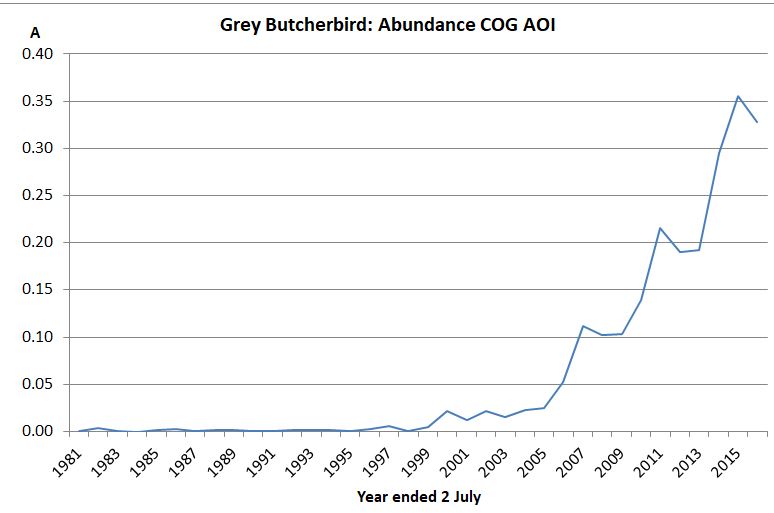I've now had a look at the data for suburbs and have come to a conclusion -
without being able to demonstrate it completely satisfactorily - that they
do support the suburb-maturation.
In summary there are a number of suburbs, mainly in North Canberra,
Belconnen and Woden which were first developed in the 1960s and GBS sites
in those suburbs start reporting increases in Butcherbird numbers around
2000. Particularly North Canberra and Woden keep growing in Butcherbird
numbers from then on.
As well as the (planted) vegetation within the suburbs maturing these areas
are all close to large areas of native vegetation on Mounts Majura, Ainslie
and Taylor from which the Butcherbirds spread out into the suburbs.
Martin
Martin Butterfield
http://franmart.blogspot.com.au/
On 16 April 2018 at 08:47, Martin Butterfield <> wrote:
> For the Canberra area there is nice data available from the COG Garden
> Bird Survey (GBS) to show the time series of abundance of birds. For those
> not familiar with the GBS - now in its 37th year - one of the key
> statistics is Abundance (A) which is the average number of birds reported
> per active site week. For Grey Butcherbird it shows a dramatic increase
> starting from 2005.
>
> I had in the past attributed the increase to the 2003 fires in the
> Brindabellas forcing the birds down to the urban area but in fact the
> increase appears to start in 1999. Possibly the rate of increase is
> boosted by the fires (and a few rural sites coming into the GBS from 2004
> onwards).
>
> What actually started the increase is a bit of a puzzle, but I suspect
> Martin (excellent name, that) Cachard is close to the money in suggesting
> the maturation of suburbs: in the case of Canberra this could be the
> suburbs in the townships of Belconnen and Northern Tuggeranong developed in
> the 1970s and 80s. I'll try and look at some detail on this later today.
>
> Martin Butterfield
>
> Martin Butterfield
> http://franmart.blogspot.com.au/
>
> On 16 April 2018 at 06:26, martin cachard <> wrote:
>
>> perhaps the increase in butcherbirds around the suburbs of Melbourne in
>> the last few decades is because there is now more suitable habitat and
>> available food.
>>
>> whenever I've visited Melb to see old friends & family, particularly
>> around the eastern burbs of Blackburn, Box Hill, the Waverley's, and the
>> Bayside areas, I have noticed some nice changes in the local native
>> birdlife there...
>>
>> because I've lived up here in gorgeous FNQ since 1996, and these Melb
>> locales were my old stomping grounds from when I was a boy and a MUCH
>> younger man, these changes are not only a pleasant surprise, but they are
>> also rather obvious to me as I'm not visiting them very often...
>>
>> in general, there are a lot more smaller birds around, like Brown
>> Thornbills, White-browed Scrub-wrens, Superb Fairy-wrens etc, in people's
>> residential gardens in these burbs. I hear butcherbirds calling in the dawn
>> chorus in pretty much every suburb I overnight in when visiting, much more
>> so than in the 70's to early 90's.
>>
>> as suburbs like these develop and mature, so does the vegetation that is
>> within them as well - it seems to me that a nice mosaic of vegetation types
>> has thus been created, and with enough shrubbery and other cover to 'bring
>> back' such smaller songbirds as these, and of course, this supports more
>> families of butcherbirds.
>>
>>
>> the increasing controls on domestic cats has no doubt helped a great deal
>> as well.
>>
>>
>> and of course, this note of mine is a very general, and possibly a
>> slightly romanticised, view of things, but I reckon that this helps to
>> explain the butcherbirds increasing, especially in the greater eastern
>> suburbs where I am from, and have been visiting in the last 22 years too...
>>
>>
>> cheers for now,
>>
>>
>> martin cachard
>>
>>
>> writing to you now from a VERY NON-cyclone ravaged FNQ...
>>
>>
>>
>>
>> ________________________________
>> From: Birding-Aus <> on behalf of
>> Peter Shute <>
>> Sent: Monday, 16 April 2018 5:07 AM
>> To: Mike Carter
>> Cc:
>> Subject: Re: [Birding-Aus] Range of Weebill
>>
>> What's the reason for the increase in butcherbirds? People feeding them?
>>
>> Peter Shute
>>
>> Sent from my iPad
>>
>> > On 15 Apr 2018, at 8:34 pm, Mike Carter <> wrote:
>> >
>> > Hi Patrick, Buff-rumped Thornbill is even more unlikely; that 2006
>> publication that I mentioned lists that species as extinct on the
>> Peninsula. Yellow-rumped Thornbill is a possibility but is distinctive so
>> unlikely to be confused and has a patchy distribution. White-browed
>> Scrubwren has a prominent white eye and would be plundered by Grey
>> Butcherbirds which have become more common in built-up areas in the last
>> three decades.
>> >
>> >
>>
>> <HR>
>> <BR> Birding-Aus mailing list
>> <BR>
>> <BR> To change settings or unsubscribe visit:
>> <BR> http://birding-aus.org/mailman/listinfo/birding-aus_birding-aus.org
>> Birding-Aus Info Page<http://birding-aus.org/ma
>> ilman/listinfo/birding-aus_birding-aus.org>
>> birding-aus.org
>> BIRDING-AUS is a discussion group for anyone with an interest in
>> Australian wild birds. Read updates and trip reports from many parts of
>> Australia.
>>
>>
>>
>> </HR>
>> <HR>
>> <BR> Birding-Aus mailing list
>> <BR>
>> <BR> To change settings or unsubscribe visit:
>> <BR> http://birding-aus.org/mailman/listinfo/birding-aus_birding-aus.org
>> </HR>
>>
>
>

<HR>
<BR> Birding-Aus mailing list
<BR>
<BR> To change settings or unsubscribe visit:
<BR> http://birding-aus.org/mailman/listinfo/birding-aus_birding-aus.org
</HR>
|

